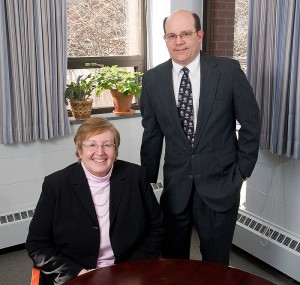People working in nonprofit organizations who would like to move up the career ladder can take a course that will help them do just that.
Last fall, UConn’s new Nonprofit Leadership Program in the Center for Continuing Studies offered its first course, Leading Nonprofit Organizations: A Learning Experience for Emerging Leaders. Held at the Greater Hartford Campus, the six-month, noncredit course is filled to capacity, with 20 students attending from around the state.

The class is designed to prepare mid-level managers for higher responsibilities and potential directorships, says David Garvey, director of the Nonprofit Leadership Program.
“The focus is to take young professionals who have three or four years of experience and help them develop their managerial skills so they become catalysts for change within their organization and the nonprofit sector.”
The program was created to meet the needs of the nonprofit workforce in Connecticut.
“Nearly 10 percent of Connecticut’s workforce is employed in the nonprofit sector, yet the state lacks sufficient managerial-level professional development programs for this workforce, Garvey says. “The nonprofit sector also faces a dramatic loss of managerial capacity in the coming decade, due to retirement of current senior leaders and a projected increase in demand for services.”
Garvey says the nonprofit sector manages a large part of Connecticut’s economy – with 4,000 organizations managing $60 billion in assets – yet there is a significant lack of higher education programs designed for the professional development of its managers.
“The key fundamentals of social service organizational management, such as governance, accounting, marketing, revenue development, and product and service design and delivery are different than for-profit business operations,” he says.
“So it’s a large market player, vital to society for the services it provides, that needs appropriate opportunities for education and professional development of its leadership in Connecticut.”
National studies show that only about a third of people who are hired as executive directors or for other high-level positions in nonprofits are promoted from within their organizations, says Garvey. “One of our program’s goals is to reverse that trend.”
The academic core of the emerging leaders course is focused on the internal management practices in Jim Collins’ book, Good to Great; the external alliance management practices in Forces for Good by Crutchfield and McLeod; and other texts in the field. The course readings provide the framework for applied discussion with guest specialists from the nonprofit world and for class web-based reflection and dialogue.
Along with Garvey, the course is facilitated by Peter DeBiasi, executive director of the Access Community Action Agency. Core topics include organizational leadership, nonprofit accounting, human resources, fund and resource development, marketing and advocacy, with a focus on developing strategic networks between government, business, and nonprofits.
Participants come from a variety of nonprofits from across the state, including youth intervention programs, community action agencies, museums and arts programs, drug rehabilitation programs, and elder care programs.
Garvey says the class offers an atmosphere where participants can learn from each other’s experiences.
“There’s a lot of discussion,” he says. “We talk about what’s happening in their organizations. Real learning occurs when people are coming from different perspectives.”
Sherry Ostrout decided to take the course because she was recently appointed director of government initiatives at Connecticut Community Care, a service for the elderly and adults with disabilities.
“I was interested in the comradeship of those dedicated to the nonprofit world, the peer process of learning, and the incredible opportunities to hear speakers,” Ostrout says.
“It’s a winning combo: incredible guest speakers, instructors, and emerging leaders,” she says. “And for me, as president of the Connecticut chapter of the National Association of Social Workers, I’m also looking at it from the viewpoint of the professional guild.”
Beth Hines, program operations director at Community Partners in Action, a program that assists people leaving the criminal justice system to successfully re-enter the community, says the course has been “extremely rewarding.
The required readings for this course correspond quite well to my daily responsibilities. I’ve learned a great deal from the readings and incorporate the learning into my work.”
Pamela Mautte is director of the Valley Substance Abuse Action Council, part of Birmingham Group Health Services. “We need to nurture and build upon people who have the potential to be great leaders in their community and organization,” she says.
“I feel this class gives us the basic skills, enhanced. The course is like giving us a mini tool box.”
The Nonprofit Leadership Program also plans to offer an undergraduate concentration in nonprofit leadership.
Another key initiative under development is Encore!Connecticut, a program to provide an inter-agency education and employment pipeline for people from the corporate and public service sectors who want to make mid-career and traditional retirement age transitions into managerial positions in the nonprofit sector. The pilot program is a partnership with the Department of Labor and the Capital Workforce Partners of Hartford, the United Way of Central and Northeastern Connecticut, and Leadership Greater Hartford.
“We’re developing Encore! Connecticut to bring the experience of mid-career and traditionally retirement-aged individuals into the nonprofit sector,” Garvey says.
“The state’s workforce is aging. We want to help the state develop a workforce pathway for the mature worker, understand the assets that he or she brings, and how to best use them in the state.”


